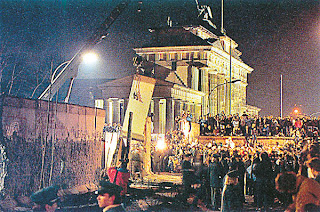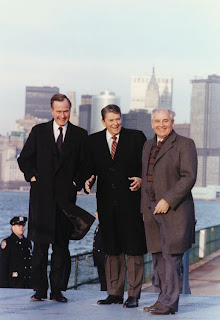The Cold War was a part of America’s history for several generations. From the fear in post-World War 2 to strength and hope at the removal of the Berlin Wall, America witnessed a great deal of change in the 40 years of the Cold War. The amount of time that passed during the Cold War meant that there were actually several turning points for the American people.
The world came out of World War 2 with a realization of the terror that a poorly-led government could visit on its people. As the United States dealt with the Soviet Union’s desire to spread communism to other countries, their decisions in dealing with the situation likely relied greatly on the fear of losing freedoms to a takeover by an unstable government system. A feeling of vulnerability in the world was a turning point for the previously robust American society. Eventually, the Cold War decisions led to a renewed strength under a charismatic president named Ronald Reagan, and an ultimate resolution with the crumbling of the Soviet Union.
EAGER BERLINERS WAVE AT AIRLIFT PLANE
In the months after World War 2, Berlin became an area of concern for many countries, including the United States. There was concern over the Soviet Union taking over Berlin and Germany, turning it into a communist area. America took its first major stand against communism by supplying Berliners with much-needed supplies, defying the Soviet's communist regime (Historical Boys' Clothing, 2008). (Photo Courtesy: Historical Boys' Clothing, 2008)
*****

In the months after World War 2, Berlin became an area of concern for many countries, including the United States. There was concern over the Soviet Union taking over Berlin and Germany, turning it into a communist area. America took its first major stand against communism by supplying Berliners with much-needed supplies, defying the Soviet's communist regime (Historical Boys' Clothing, 2008). (Photo Courtesy: Historical Boys' Clothing, 2008)
*****

FIDEL CASTRO AND SOVIET PRESIDENT NIKITA KHRUSHCHEV
In February 1959, a new leader named Fidel Castro came to power on the small island nation of Cuba. The close proximity of Cuba to the United States made it a popular new ally for the Soviets. The countries became fast friends and soon enacted trade pacts that were especially beneficial to Cuba. This agreement soon led to the Soviets being able to place missile sites in Cuba (PBS Online, 2004). (Photo Courtesy: PBS Online, 2004)
*****
TELEVISED FALLOUT SHELTER PROMOTION
In the United States, residents were coming to a realization about the potential dangers of a nuclear attack. The government provided pamphlets and televised presentations of preventative measures residents should take (Nebraskastudies.org, n.d.). Americans were encouraged to build their own fallout shelters, stocked with necessities to survive a nuclear bombing. (Photo Courtesy: Clugston, 2002)
*****

In the United States, residents were coming to a realization about the potential dangers of a nuclear attack. The government provided pamphlets and televised presentations of preventative measures residents should take (Nebraskastudies.org, n.d.). Americans were encouraged to build their own fallout shelters, stocked with necessities to survive a nuclear bombing. (Photo Courtesy: Clugston, 2002)
*****

SENATOR MCCARTHY'S TELEGRAM ABOUT COMMUNISTS IN AMERICA
As the fear grew at home so did the hysteria. Wisconsin Senator Joseph McCarthy started a witchhunt of sorts by accusing 205 people in the State Department of being communists. For several years he continued to accuse people of being communists despite a lack of substantiation. At the encouragement of Vice-President Richard Nixon and others in the Eisenhower Administration, Americans began to question McCarthy's motives and information (Oracle, n.d.). (Photo Courtesy: National Archives, n.d.)
*****
As the fear grew at home so did the hysteria. Wisconsin Senator Joseph McCarthy started a witchhunt of sorts by accusing 205 people in the State Department of being communists. For several years he continued to accuse people of being communists despite a lack of substantiation. At the encouragement of Vice-President Richard Nixon and others in the Eisenhower Administration, Americans began to question McCarthy's motives and information (Oracle, n.d.). (Photo Courtesy: National Archives, n.d.)
*****
AMERICAN U2 SPY PLANE SHOT DOWN IN SOVIET UNION
On May 1, 1960, an American U2 spy plane was shot down over the Soviet Union. The pilot, Francis Gary Powers, survived the crash and was imprisoned in Russia. The event proved humiliating to President Eisenhower who denied knowledge of the spy flight. This situation created a tremendous amount of tension between the two countries. Powers was eventually brought home through a spy exchange in 1962 (Pound High School, 2010). (Photo Courtesy: Malcomson, 2010)
*****
On May 1, 1960, an American U2 spy plane was shot down over the Soviet Union. The pilot, Francis Gary Powers, survived the crash and was imprisoned in Russia. The event proved humiliating to President Eisenhower who denied knowledge of the spy flight. This situation created a tremendous amount of tension between the two countries. Powers was eventually brought home through a spy exchange in 1962 (Pound High School, 2010). (Photo Courtesy: Malcomson, 2010)
*****
NEWSPAPER: CUBAN MISSILE CRISIS
In the autumn of 1962, the threat of communism arrived in the small island nation of Cuba, approximately 350 miles from Florida (True Knowledge, n.d.). U.S. spy planes captured footage of Soviet-built nuclear missile sites in Cuba. The ensuing American naval blockade brought about a threat of nuclear war, but eventually led to the Soviet Union backing down. The nuclear missile sites were removed and war was averted (John F. Kennedy Presidential Library and Museum, n.d.). (Photo Courtesy: Mitchell Archives, 2009)
*****
In the autumn of 1962, the threat of communism arrived in the small island nation of Cuba, approximately 350 miles from Florida (True Knowledge, n.d.). U.S. spy planes captured footage of Soviet-built nuclear missile sites in Cuba. The ensuing American naval blockade brought about a threat of nuclear war, but eventually led to the Soviet Union backing down. The nuclear missile sites were removed and war was averted (John F. Kennedy Presidential Library and Museum, n.d.). (Photo Courtesy: Mitchell Archives, 2009)
*****
CUBAN MISSILE CRISIS PROTESTORS
As America stood on the brink of nuclear war during the Cuban Missile Crisis, protestors urged President Kennedy to find a non-combat resolution to the situation. Their urging showed the great concern felt by many Americans, not eager to have Soviet missiles within striking distance but not ready for war (Oregon Historical Society, 2002). (Photo Courtesy: Oregon Historical Society, 2002)
*****
As America stood on the brink of nuclear war during the Cuban Missile Crisis, protestors urged President Kennedy to find a non-combat resolution to the situation. Their urging showed the great concern felt by many Americans, not eager to have Soviet missiles within striking distance but not ready for war (Oregon Historical Society, 2002). (Photo Courtesy: Oregon Historical Society, 2002)
*****
GLASNOST POSTER
The beginning of the end of the Cold War came about with the leadership of Soviet Union President Mikhail Gorbachev. His quest to bring a new openness to the Soviet Union was called Glasnost (Rosenberg, n.d.). It helped build trust between the two countries, despite the many years of distrust. (Photo Courtesy: Pix.fr, n.d.)
*****
The beginning of the end of the Cold War came about with the leadership of Soviet Union President Mikhail Gorbachev. His quest to bring a new openness to the Soviet Union was called Glasnost (Rosenberg, n.d.). It helped build trust between the two countries, despite the many years of distrust. (Photo Courtesy: Pix.fr, n.d.)
*****
THE BERLIN WALL IS TORN DOWN
Generations of Berliners lived with a divided city thanks to a concrete wall erected in 1965 to keep the communist east from mingling with the free west. As the Soviet Union and its communist neighbors began to see their governments crumble, the tearing down of the Berlin Wall in November 1989 was a symbolic representation of the end of the Cold War (Berlin-life.com, n.d.). (Photo Courtesy: Wagner, 2009)
*****
Generations of Berliners lived with a divided city thanks to a concrete wall erected in 1965 to keep the communist east from mingling with the free west. As the Soviet Union and its communist neighbors began to see their governments crumble, the tearing down of the Berlin Wall in November 1989 was a symbolic representation of the end of the Cold War (Berlin-life.com, n.d.). (Photo Courtesy: Wagner, 2009)
*****
VICE PRESIDENT BUSH, PRESIDENT REAGAN, AND SOVIET PRESIDENT GORBACHEV
The true end of the Cold War came with a new understanding between President Ronald Reagan and Soviet Leader Mikhail Gorbachev. The two began a series of summits meant to encourage communication and better understanding that might eliminate some of the previous distrust (National Security Archive, 2005). This ended up being the ultimate turning point as tensions relieved, and the Soviet Union eventually collapsed. (Photo Courtesy: Cassidy, 2009)
*****
The true end of the Cold War came with a new understanding between President Ronald Reagan and Soviet Leader Mikhail Gorbachev. The two began a series of summits meant to encourage communication and better understanding that might eliminate some of the previous distrust (National Security Archive, 2005). This ended up being the ultimate turning point as tensions relieved, and the Soviet Union eventually collapsed. (Photo Courtesy: Cassidy, 2009)
*****
References:
Berlin-life.com. (n.d.). The Berlin Wall. Retrieved from http://www.berlin-life.com/berlin/wall
Cassidy, B. (2009). History of U.S. foreign relations since 1898. Retrieved from http://faculty.washington.edu/bcasserl/HSTAA462/home.shtml
Clugston, S. (2002). Cold War and hot spots. Retrieved from http://www.marchfield.org/coldwar.htm
Clugston, S. (2002). Cold War and hot spots. Retrieved from http://www.marchfield.org/coldwar.htm
Historical Boys' Clothing. (2008, February 18). The Cold War (1945-91). Retrieved from http://histclo.com/essay/war/cold/war-cold.html
John F. Kennedy Presidential Library and Museum. (n.d.). Cuban Missile Crisis. Retrieved from http://www.jfklibrary.org/JFK/JFK-in-History/Cuban-Missile-Crisis.aspx
Malcomson, R. (2010, March 11). U.S. and the Soviet Union: Tensions increase: Spy plane mystery. Retrieved from http://mrmworldciv.blogspot.com/2010/03/us-and-soviet-union-tensions-increase.html
Malcomson, R. (2010, March 11). U.S. and the Soviet Union: Tensions increase: Spy plane mystery. Retrieved from http://mrmworldciv.blogspot.com/2010/03/us-and-soviet-union-tensions-increase.html
Mitchell Archives. (2009). The Cuban Missile Crisis- Blockade. Retrieved from http://mitchellarchives.com/the-cuban-missile-crisis-blockade.htm
National Archives. (n.d.) Teaching with documents: Telegram from Senator Joseph McCarthy to President Harry S. Truman. Retrieved from http://phs1.org/U2%20Program/Francis_Gary_Powers.htm
National Archives. (n.d.) Teaching with documents: Telegram from Senator Joseph McCarthy to President Harry S. Truman. Retrieved from http://phs1.org/U2%20Program/Francis_Gary_Powers.htm
National Security Archive. (2005, November 22). To the Geneva Summit. Retrieved from http://www.gwu.edu/~nsarchiv/NSAEBB/NSAEBB172/index.htm
Nebraskastudies.org. (n.d.). The family fallout shelter. Retrieved from http://www.nebraskastudies.org/0900/frameset_reset.html?http://www.nebraskastudies.org/0900/stories/0901_0132.html
Oracle. (n.d.) Senator Joseph McCarthy. Retrieved from http://library.thinkquest.org/10826/mccarthy.htm
Nebraskastudies.org. (n.d.). The family fallout shelter. Retrieved from http://www.nebraskastudies.org/0900/frameset_reset.html?http://www.nebraskastudies.org/0900/stories/0901_0132.html
Oracle. (n.d.) Senator Joseph McCarthy. Retrieved from http://library.thinkquest.org/10826/mccarthy.htm
Oregon Historical Society. (2002). (no title) Retrieved from http://www.ohs.org/education/oregonhistory/historical_records/dspDocument.cfm?doc_ID=0008E4D3-1F29-1E93-891B80B0527200A7
PBS Online. (2004, December 21). Fidel Castro. Retrieved from http://www.pbs.org/wgbh/amex/castro/peopleevents/e_coldwar.html
Pix.fr. (n.d.). Glasnost. Retrieved from http://pixfr.eu/image/feca3097/
Pound High School. (2010, December 3). Francis Gary Powers. Retrieved from http://phs1.org/U2%20Program/Francis_Gary_Powers.htm
Rosenberg, J. (n.d.) What was Gorbachev's policy of Glasnost? Retrieved from http://history1900s.about.com/od/1980s/qt/glasnost.htm
PBS Online. (2004, December 21). Fidel Castro. Retrieved from http://www.pbs.org/wgbh/amex/castro/peopleevents/e_coldwar.html
Pix.fr. (n.d.). Glasnost. Retrieved from http://pixfr.eu/image/feca3097/
Pound High School. (2010, December 3). Francis Gary Powers. Retrieved from http://phs1.org/U2%20Program/Francis_Gary_Powers.htm
Rosenberg, J. (n.d.) What was Gorbachev's policy of Glasnost? Retrieved from http://history1900s.about.com/od/1980s/qt/glasnost.htm
True Knowledge. (n.d.). Distance between Florida and Cuba. Retrieved from http://www.trueknowledge.com/q/distance_between_florida_and_cuba
Wagner, T. (2009, November 6). Tearing down walls. Retrieved from http://wagnerblog.com/








No comments:
Post a Comment